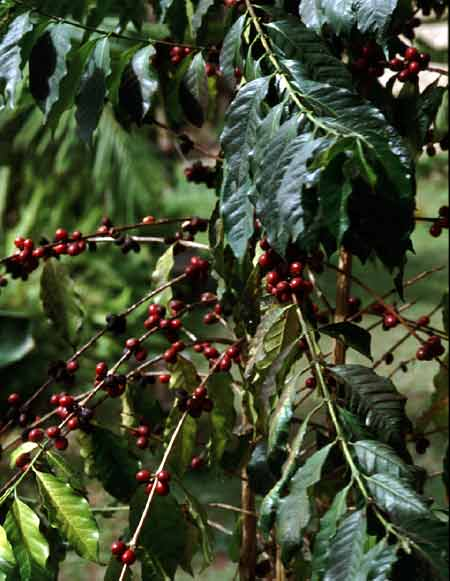Coffee
Scientific Name: Coffea
Climate: Hot and warm. Coffee is a tropical plant that is also grown in a semi-tropical climate. The coffee tree requires heat, and humidity.
Plant Description: It grows to the size of a small tree (3-3.5m high).
The genus Coffea is native to tropical Africa, Madagascar, the Comoros, Mauritius and Reunion Island in the Indian Ocean. The plant was exported from Africa to countries all over the world, mainly in the equatorial regions of the Americas, Southeast Asia, India and places with a similar climate to its natural habitat in Africa.
Cultivation: The traditional method of planting coffee is to place 20 seeds in each hole at the beginning of the rainy season. This method loses approximately 50% of the potential of the seeds, as approximately half do not grow. A more effective method of growing coffee, used in Brazil, is to plant seeds in nurseries which are then planted out after six to twelve months. Coffee is planted alongside food crops, such as corn, beans or rice during the first few years of cultivation. The ripe beans are either harvested by hand, separated from the tree with immature and over-ripe beans, or all the coffee beans are picked using a harvesting machine.
Direct sunlight is harmful to coffee plants; therefore, they are planted under the shade of taller trees such as bananas. Coffee needs abundant rainfall, 100 to 200 cm annually. The ideal soil is one with good drainage, and one that is workable. Cultivated on slopes with a height of 600-1,800m.
 Uses: Coffee can improve energy levels, caffeine can dramatically improve physical performance, can reduce your risk of type II diabetes, and appears to have protective effects on the liver.
Uses: Coffee can improve energy levels, caffeine can dramatically improve physical performance, can reduce your risk of type II diabetes, and appears to have protective effects on the liver.
Pests and Diseases: Removing beans left on the plants after harvest and fallen beans and debris from the plantation floor can help reduce sources of infections.
En español: Café

